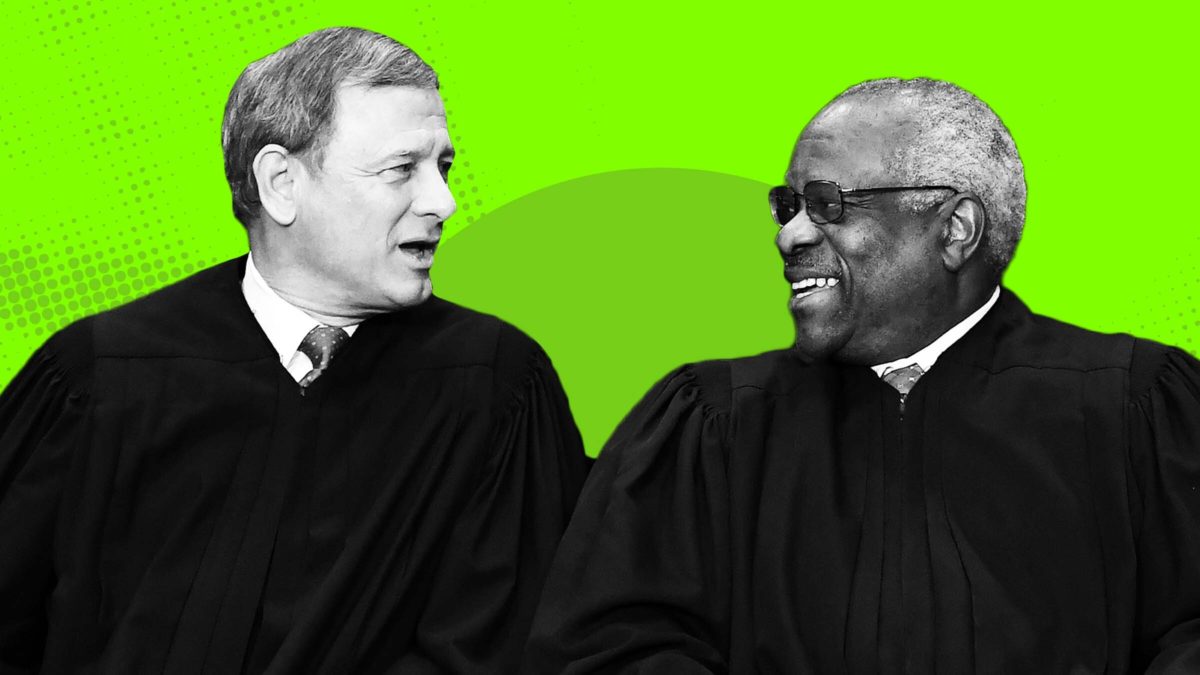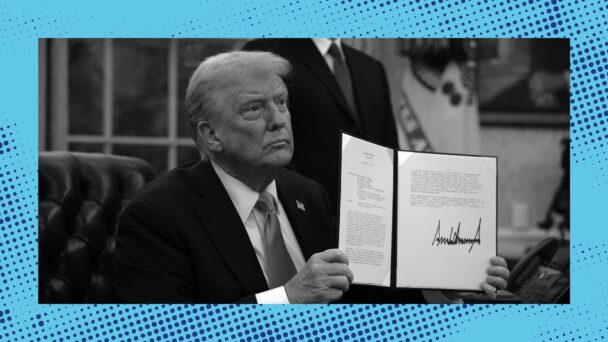Donald Trump has a guardian angel, and its name is the Supreme Court of the United States. On the heels of the Court’s decision to hear Trump’s implausible claim of blanket immunity from criminal prosecution, thus delaying any actual prosecution for at least several more months after oral argument in April, the conservative supermajority has again intervened to keep Trump’s presidential candidacy afloat.
Last year, the Colorado Supreme Court found that Trump had “engaged in insurrection” in violation of Section 3 of the Fourteenth Amendment, and consequently barred him from appearing on the state’s presidential ballot in 2024. On Monday, the Supreme Court overturned that decision in Trump v. Anderson, with all nine justices agreeing that states do not have the authority to enforce the constitutional prohibition on insurrectionists holding office.
Beneath this veneer of unanimity, though, the reasoning is more fractious. The five Republican men on the Court all assert that Congress must enact legislation in order to implement Section 3, a post-Civil War amendment which says that no person who previously took an oath of office and then violated that oath by “engaging in insurrection” can hold office again. The three women appointed by Democrats concurred only in the judgment: They agreed that states don’t have the authority to enforce Section 3 against would-be federal officeholders, but argued that the majority, by declaring Congress solely (legislatively) responsible for enforcing the Constitution’s plain text, went much further than necessary to decide the case.
The Court’s lone Republican woman settled on a patronizing middle ground. Justice Amy Coney Barrett agreed the majority overstepped, but urged her liberal colleagues to “turn the national temperature down” and not “amplify disagreement with stridency” on such a “politically charged issue in the volatile season of a Presidential election.” Sure, the Court is making the Fourteenth Amendment meaningless, but please don’t be so shrill about it.

“Amy write the smartest thing you can think of” (Photo by Tom Williams-Pool/Getty Images)
The token resistance offered in both Barrett’s and the liberals’ concurrences underscore one of the greatest indignities with the opinion itself: whatever their nominal disagreements, the justices are effectively arguing over off-ramps. The Supreme Court has always been skittish about applying the Fourteenth Amendment as boldly as its drafters designed it. Thus, it was more or less a given that the justices would not allow Colorado to remove Trump from the ballot. Rather, the question was about which bullshit rationale for the outcome would be less embarrassing.
Federalism provided the most comfortable refuge for five justices in the majority, who warned of the disruption an “evolving electoral map” could pose to the political process if individual states could declare federal candidates ineligible. “Nothing in the Constitution requires that we endure such chaos,” the author wrote. The liberal justices agreed, writing that allowing Colorado to keep Trump off the ballot would “create a chaotic state-by-state patchwork” that is “at odds with our Nation’s federalism principles.” If any of the justices thought at all about the chaotic consequences of allowing an oath-breaking insurrectionist to remain on the ballot in violation of the Constitution, they must have kept those thoughts to themselves.
All justices relied on predictable and perverse invocations of history. Since states haven’t previously disqualified candidates for federal office under the Fourteenth Amendment, the majority said, that probably means states can’t do so at all. Obviously, states haven’t enforced the insurrectionist ban against a presidential candidate before because the country never had a president forment an insurrection before. The Court similarly ignores the fact that it relied on the exact opposite reasoning when overturning Roe v. Wade just two years ago: In Dobbs, the Court argued that just because no state had banned all abortions, it didn’t mean states lacked the authority to do so. Here, the Court says no state banned insurrectionists because they lacked the authority to do so. The Court ascribes different meaning to congressional action and inaction depending on which one serves the Republican Party’s goals.
The liberals, for their part, emphasized how Reconstruction altered the relationship between states and the federal government. It would be “surprising,” they said, if “a handful of officials in a few States could decide the Nation’s next President,” considering that the Reconstruction Amendments “were specifically designed as an expansion of federal power and an intrusion on state sovereignty.” This evinces a cramped understanding of the priorities and principles of the Reconstruction Amendments. The lawmakers who enacted them were specifically trying to limit states’ power to inhibit multiracial democracy. Blocking states from actually pursuing that objective by enforcing the Reconstruction Amendments—specifically against a candidate who actively imperiled multiracial democracy by trying to nullify the votes of millions of people of color—undermines the Amendments’ goal of ensuring “We the People” includes Black people, too.
With these halfhearted justifications, for the second time in my life, the Supreme Court is going out of its way to destabilize democracy by putting a Republican thumb on the scale in a presidential election. There are even some repeat players: three justices who participated in Anderson served on George W. Bush’s legal team in Bush v. Gore.
Yes, you can add Trump v. Anderson to the ever-expanding list of decisions evidencing a complete lack of interest by the courts or the feckless judges who sit on them in serving the interests of democracy. But the standard advice in situations like this one for people who care about democracy—just win at the ballot box—is of little help here. The American people already did that. The loser didn’t give a damn, and the Supreme Court doesn’t either.




